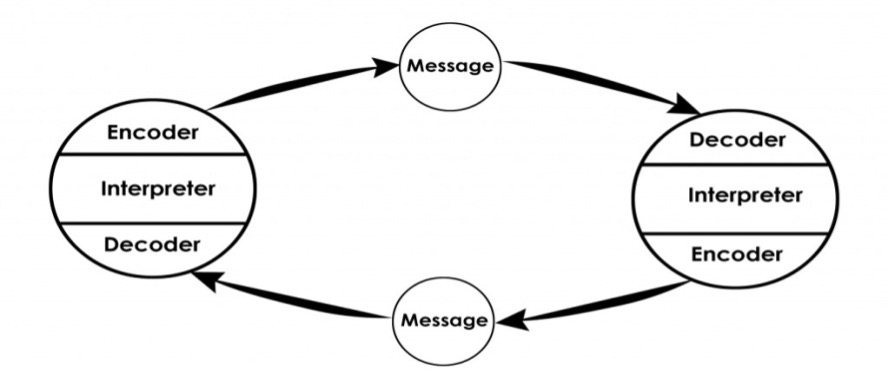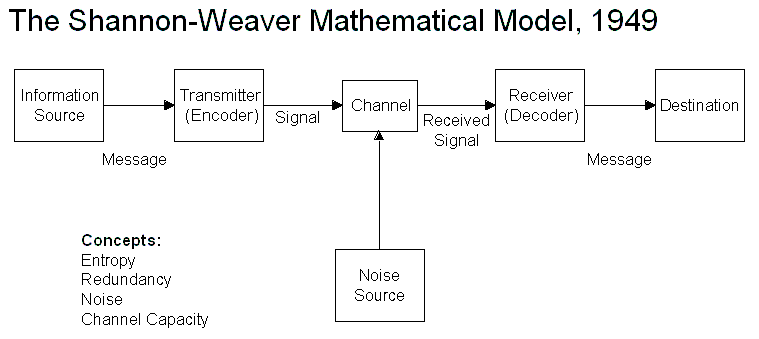💬 Communication
Learn basics of Communication.
Communication
- The word communication is derived from
Latinword “communis” meanscommon. - “Process by which two or more people sharing of ideas, facts, feelings or impressions in ways of common understanding of the meaning, intent and use of messages” according to
Leagans.
Types of Communication
1. Verbal
- On an average, a person spends
70 %of his time in communicating verbally. - While communicating verbally,
30 %message distorted.
2. Non-verbal
- Generally
40 %of communication takes place through body language. - Gestures, postures, facial expression etc. are component of non-verbal communication.
Models of communication
- A large number of communication models exist because of contextual variation.
1. Aristotal’s model (384-322 BC)
- It was first basic persuasive communication model.

2. Lasswell’s Communication Sequence (1948)
- This model helped Lasswell’s probes into
political communication,propaganda&political symbolism, which were some of the earliest communication researches in social science. - The model containing words “Who says, what, which channel, to whom & what effect”.

3. Stimulation-Response Model (SR Model)
A ----------------------------> B = X
- Proposed by
Stevens. - A/Q to Stevens, Communication is the discriminatory response of an organisation to the stimulus.
- It is sometimes also called
interpersonal communication.
4. Schramm’s model (1961) SESDD
- A/Q to him accumulated field of experience of both the
source-encoder& thedecoder-receivermust be common for achieving maximum output. (Tuned together)

- According to Schramm, “Each person in the communication process is both an encoder & decoder”. He receives & transmits.
- And it is misleading to think of the communication process as starting somewhere and ending somewhere. Rather, it is continuous.

5. Shannon-weaver’s Mathematical Theory (1949)
- This model is
best suited for broadcastof farm information. Mathematical theoryof communication.Information Theory

He saw three levels of problems in the communication of information:
- Technical problems: It includes the problem of accuracy of information transferred from sender to the receiver.
- Semantic problems: Semantic is the study of meaning of words and language. Here people attach different meaning to things.
- Influence problems: These are concerned with the success with which the meaning conveyed to the receiver leads to the desired behaviour on his part.
Some important concepts introduced by him:
Entropy: The degree of randomness or choices or ones degree of freedom to select a message.Redundancy: This refers to the amount of information that could be omitted or added in a noiseless channel, so that the massage would still retain information or meaning. The English language has been proven to be approximately 50% redundant.Noise: This refers to any sound, distortion etc. that may be added into the channel which is not intended by the communicator. All communication signals are subjected to noise which is actually beyond the control of the transmitter or receiver.Channel Capacity: The amount of information that can be transmitted per unit time.
6. Berlo’s model of communication (1960) [SMRC]
- Berolo is also known as
Father of Communication. - This includes four basic elements:
SMCR.

A/Q to him, ingredients in a communication process include: (There are 6 elements in Berlo Model)
- Source
- Encoder
- Message
- Channel
- Decoder
- Receiver
7. Leagan’s model (1963) [CMCTAR]
- He defined communication as a process by which two or more people exchange ideas, facts, feelings, impressions, in a ways that each gains a clear understanding of the meaning, intent & use of the message.

- Leagan’s emphasis on treatment of message & audience response comes from his background in extension education. So, this model is best described to have applicable for field extension work.
8. Rogers and Shoemaker’s model (1971) [SMCRE]
Elements of communication
- Remember basic elements of communication are
Source,Message,Channel&Receiver. - A/Q to Leagens, there are
6 elementsof communication:

I. Communicator
- It is person who initiates the process of communication. He is the source, originator or sender of messages.
- Attitude of communication source is important from the point of view of: Self, audience & content.
- Communication behaviour: Defined as his expression of results from information seeking, information processing & information disseminating behaviour.
- Berlo pointed out there are 5 verbal communication skills. Two of these are encoding skills, writing and speaking while two of them are decoding skills, reading and listening. The fifth is crucial to both encoding & decoding, i.e. thought and reasoning.
II. Message
- The actual physical product of source-encounter is message.
- Dimensions of Message given by Berlo:
- Message Code
- Message Content
- Message Treatment
- The basic speech sounds are called
phonemes. - The smallest meaningful unit of speech is called
morphemes. - The rule for word order in sentences is known as
syntax.
Message Flow Model
- The hypodermic needle model (also known as the hypodermic-syringe model) this model hypothesises that the information flows direct the masses waiting to receive it, with nothing intervening. A/Q to it, mass media had direct, immediate & powerful effects on a mass audience.
- Two-step flow model: A/Q to this model ideas flow from radio & print to some active members of a social system called
key communicators& from them to less active members of the audience.
Types of message distortion: (Explained by Kirk)
a) Systematic: In this no information is lost, rather it is changed or recorded in an orderly or systematic way. Thus in this case the information is purposely changed in a systematic way to serve some specific objectives. This type of distortion may be useful for extension workers for effective treatment of the message.
b) Fog distortion: Information is lost, masked or fogged over, because of the inability of the communicator to encode and/or the inability of the receiver to decode the message with the complete fidelity.
c) Mirage: We see something that ‘is not there’. Far from withholding information from us, mirage distortion gives us extra, unwanted information. Here loss of message is maximum.
III. Channel
- A/Q to Leagans, channel is a physical bridge between the sender & the receiver of message.
- It is the link which connects source to the receiver.
- The controlling of the flow of information through a communication channel is called
gate keeping. Rogers & Shoemaker, based on a large number of research studies, drew the following generalisations: - Interpersonal channels are most suited in persuading an individual to accept new idea and mass media channels are relatively more important at the knowledge function.
- Mass media channels are relatively more important than interpersonal channels for early adopters than for late adopters.
- Cosmopolite channels are relatively more important at the knowledge function, and localite channels are relatively more important at the persuasion function.
- Cosmopolite channels are relatively more important than localite channels for early adopters than for later adopters.
IV. Treatment
- Treatment is the way in which message is handled before placing in the channel.
V. Audience
- Receiver is the
most important elementin the communication process. - Active audience is suited for communication process.
VI. Audience Response
- Terminating element in communication process is audience response.
- Ultimate objective of any communication function is audience response.
- Communication strategy that consists of identifying certain sub-audiences within a total audience & the conveying a special message to each of these sub-audience is
audience segmentation. - Carrying some significant response back to the communicator is
feedback.
Feedback
- Concept of feedback was given by
Berlo. - It is action-reaction inter-dependence in communication.
- It stabilise the communication process.
- Acceptance & rejection are the one of kind of feedback.
- Feedback is source oriented.
Barriers in Teaching Methods
- Providing too much information (
communication overload) is a communication barrier related to communicator. - The problem if accuracy of information transferred from sender to receiver is technical problem.
- The communication barrier wherein people attach different meaning to things is semantic barrier.
Noise
- It is an obstruction in communication.
Disadvantage
- Wastage of time & energy: Main disadvantage
- Pollution in environment
- Divert the attention
- Distort the message
Communication
- The word communication is derived from
Latinword “communis” meanscommon. - “Process by which two or more people sharing of ideas, facts, feelings or impressions in ways of common understanding of the meaning, intent and use of messages” according to
Leagans.
Types of Communication
1. Verbal
- On an average, a person spends
70 %of his time in communicating verbally. - While communicating verbally,
30 %message distorted.
2. Non-verbal
- Generally
40 %of communication takes place through body language. - Gestures, postures, facial expression etc. are component of non-verbal communication.
Models of communication
- A large number of communication models exist because of contextual variation.
1. Aristotal’s model (384-322 BC)
- It was first basic persuasive communication …
Become Successful With AgriDots
Learn the essential skills for getting a seat in the Exam with
🦄 You are a pro member!
Only use this page if purchasing a gift or enterprise account
Plan
- Unlimited access to PRO courses
- Quizzes with hand-picked meme prizes
- Invite to private Discord chat
- Free Sticker emailed
Lifetime
- All PRO-tier benefits
- Single payment, lifetime access
- 4,200 bonus xp points
- Next Level
T-shirt shipped worldwide

Yo! You just found a 20% discount using 👉 EASTEREGG

High-quality fitted cotton shirt produced by Next Level Apparel